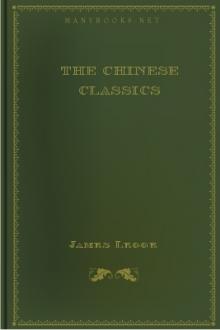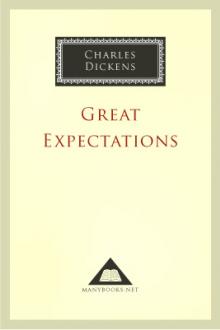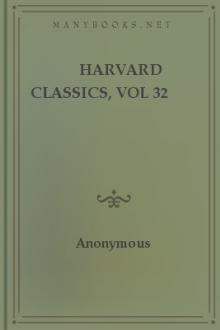The Chinese Classics (Prolegomena) by James Legge (e novels to read .txt) 📕

- Author: James Legge
- Performer: -
Book online «The Chinese Classics (Prolegomena) by James Legge (e novels to read .txt) 📕». Author James Legge
Hardly less illustrious than Ch’ang Hao was his younger brother Ch’ang I, known by the style of Chang-shu [6], and since his death by that of I-chwan [7]. He followed Hao in the adoption of the reading ‘to renovate,’ instead of ‘to love.’ But he transposed the text differently, more akin to the arrangement afterwards made by Chu Hsi, suggesting also that there were some superfluous sentences in the old text which might conveniently be erased. The Work, as proposed to be read by him, will be found in the volume of Mao just referred to.
We come to the name of Chu Hsi who entered into the labors of the brothers Ch’ang, the young of whom he styles his Master, in his introductory note to the Great Learning. His arrangement of the text is that now current in all the editions of the Four Books, and it had nearly displaced the ancient text
1 �{�l�V�M�r�B�E�M�e�n�M�����H.
2 ���D.
3 �s.
4 ��.
5 �j����.
6 �{�l�[�M�r�����M���D����.
7 ���t.
altogether. The sanction of Imperial approval was given to it during the Yuan and Ming dynasties. In the editions of the Five Ching published by them, only the names of the Doctrine of the Mean and the Great Learning were preserved. No text of these Books was given, and Hsi-ho tells us that in the reign of Chia-ching [1], the most flourishing period of the Ming dynasty (A.D.
1522-1566), when Wang Wan-ch’ang [2] published a copy of the Great Learning, taken from the T’ang edition of the Thirteen Ching, all the officers and scholars looked at one another in astonishment, and were inclined to supposed that the Work was a forgery. Besides adopting the reading of sin for ch’in from the Ch’ang, and modifying their arrangements of the text, Chu Hsi made other innovations. He first divided the whole into one chapter of Classical text, which he assigned to Confucius, and then chapters of Commentary, which he assigned to the disciple Tsang. Previous to him, the whole had been published, indeed, without any specification of chapters and paragraphs. He undertook, moreover, to supply one whole chapter, which he supposed, after his master Ch’ang, to be missing.
Since the time of Chu Hsi, many scholars have exercised their wit on the Great Learning. The work of Mao Hsi-ho contains four arrangements of the text, proposed respectively by the scholars Wang Lu-chai [3], Chi P’ang-shan [4], Kao Ching-yi [5], and Ko Ch’i-chan [6]. The curious student may examine them here.
Under the present dynasty, the tendency has been to depreciate the labors of Chu Hsi. The integrity of the text of Chang Hsuan is zealously maintained, and the simpler method of interpretation employed by him is advocated in preference to the more refined and ingenious schemes of the Sung scholars. I have referred several times in the notes to a Work published a few years ago, under the title of ‘The Old Text of the sacred Ching, with Commentary and Discussions, by Lo Chung-fan of Nan-hai [7].’ I knew the man many years ago. He was a fine scholar, and had taken the second degree, or that of Chu-zan. He applied to me in
1843 for Christian baptism, and, offended by my hesitancy, went and enrolled himself among the disciples of another missionary. He soon, however,
1 ���t.
2 ������.
3 ���|��.
4 ���^�s.
5 �����h.
6 ������
7 �t�g�j��,�n������������.
withdrew into seclusion, and spent the last years of his life in literary studies. His family have published the Work on the Great Learning, and one or two others. He most vehemently impugns nearly every judgment of Chu Hsi; but in his own exhibitions of the meaning he blends many ideas of the Supreme Being and of the condition of human nature, which he had learned from the Christian Scriptures.
SECTION II. OF THE AUTHORSHIP, AND DISTINCTION OF THE TEXT INTO CLASSICAL TEXT AND COMMENTARY.
1. The authorship of the Great Learning is a very doubtful point, and one on which it does not appear possible to come to a decided conclusion. Chu Hsi, as I have stated in the last section, determined that so much of it was Ching, or Classic, being the very words of Confucius, and that all the rest was Chwan, or Commentary, being the views of Tsang Shan upon the sage’s words, recorded by his disciples. Thus, he does not expressly attribute the composition of the Treatise to Tsang, as he is generally supposed to do. What he says, however, as it is destitute of external support, is contrary also to the internal evidence. The fourth chapter of commentary commences with ‘The Master said.’ Surely, if there were anything more, directly from Confucius, there would be an intimation of it in the same way. Or, if we may allow that short sayings of Confucius might be interwoven with the Work, as in the fifteenth paragraph of the tenth chapter, without referring them expressly to him, it is too much to ask us to receive the long chapter at the beginning as being from him. With regard to the Work having come from the disciples of Tsang Shan, recording their master’s views, the paragraph in chapter sixth, commencing with ‘The disciple Tsang said,’ seems to be conclusive against such an hypothesis. So much we may be sure is Tsang’s, and no more. Both of Chu Hsi’s judgments must be set aside. We cannot admit either the distinction of the contents into Classical text and Commentary, or that the Work was the production of Tsang’s disciples.
2. Who then was the author? An ancient tradition attributes it to K’ung Chi, the grandson of Confucius. In a notice published, at the time of their preparation, about the stone slabs of Wei, the
following statement by Chia K’wei, a noted scholar of the first century, is found:— ‘When K’ung Chi was living, and in straits, in Sung, being afraid lest the lessons of the former sages should become obscure, and the principles of the ancient sovereigns and kings fall to the ground, he therefore made the Great Learning as the warp of them, and the Doctrine of the Mean as the woof [1].’ This would seem, therefore, to have been the opinion of that early time, and I may say the only difficulty in admitting it is that no mention is made of it by Chang Hsuan. There certainly is that agreement between the two treatises, which makes their common authorship not at all unlikely.
3. Though we cannot positively assign the authorship of the Great Learning, there can be no hesitation in receiving it as a genuine monument of the Confucian school. There are not many words in it from the sage himself, but it is a faithful reflection of his teachings, written by some of his followers, not far removed from him by lapse of time. It must synchronize pretty nearly with the Analects, and may be safely referred to the fifth century before our era.
SECTION III. ITS SCOPE AND VALUE.
1. The worth of the Great Learning has been celebrated in most extravagant terms by Chinese writers, and there have been foreigners who have not yielded to them in their estimation of it. Pauthier, in the ‘Argument Philosphique,’ prefixed to his translation of the Work, says:— ‘It is evident that the aim of the Chinese philosopher is to exhibit the duties of political government as those of the perfecting of self, and of the practice of virtue by all men. He felt that he had a higher mission than that with which the greater part of ancient and modern philosophers have contented themselves; and his immense love for the happiness of humanity, which dominated over all his other sentiments, has made of his
1 ������������,���Q�������g�_�Q��,���~���f����,��,�����a�~�_��,�����t ��������,���������D�Y,�G�@�j���H�g��,���e�H�n��; see the �j������,�@, p. 5.
philosophy a system of social perfectionating, which, we venture to say, has never been equalled.’
Very different is the judgment passed upon the treatise by a writer in the Chinese Repository: ‘The Ta Hsio is a short politico-moral discourse. Ta Hsio, or “Superior Learning,” is at the same time both the name and the subject of the discourse; it is the summum bonum of the Chinese. In opening this Book, compiled by a disciple of Confucius, and containing his doctrines, we might expect to find a work like Cicero’s De Officiis; but we find a very different production, consisting of a few commonplace rules for the maintenance of a good government [1].’
My readers will perhaps think, after reading the present section, that the truth lies between these two representations.
2. I believe that the Book should be styled T’ai Hsio [2], and not Ta Hsio, and that it was so named as setting forth the higher and more extensive principles of moral science, which come into use and manifestation in the conduct of government. When Chu Shi endeavours to make the title mean — ‘The principles of Learning, which were taught in the higher schools of antiquity,’ and tells us how at the age of fifteen, all the sons of the sovereign, with the legitimate sons of the nobles, and high officers, down to the more promising scions of the common people, all entered these seminaries, and were taught the difficult lessons here inculcated, we pity the ancient youth of China. Such ‘strong meat’ is not adapted for the nourishment of youthful minds. But the evidence adduced for the existence of such educational institutions in ancient times is unsatisfactory, and from the older interpretation of the title we advance more easily to contemplate the object and method of the Work.
3. The object is stated definitely enough in the opening paragraph: ‘What the Great Learning teaches, is — to illustrate illustrious virtue; to love the people; and to rest in the highest excellence.’ The political aim of the writer is here at once evident. He has before him on one side, the people, the masses of the empire, and over against them are those whose work and duty, delegated by Heaven, is to govern them, culminating, as a class, in ‘the son of Heaven [3],’ ‘the One man [4],’ the sovereign. From the fourth and
1 Chinese Repository, vol. iii. p. 98
2 ����, not �j��. See the note on the title of the Work below.
3 ���l, Cl. (classical) Text, par. 6, 2.
4 �@�H, Comm. ix. 3.
fifth paragraphs, we see that if the lessons of the treatise be learned and carried into practice, the result will be that ‘illustrious virtue will be illustrated throughout the nation,’ which will be brought, through all its length and breadth, to a condition of happy tranquillity. This object is certainly both grand and good; annd if a reasonable and likely method to secure it were proposed in the Work, language would hardly supply terms adequate to express its value.
4. But the above account of the object of the Great Learning leads us to the conclusion that the student of it should be a sovereign. What interest can an ordinary man have in it? It is high up in





Comments (0)